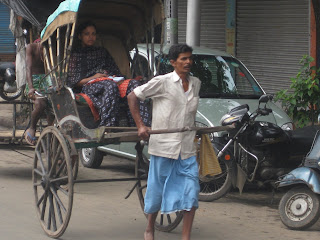
Multiple people gathered around during
our visit to the rural village. The last group
of Americans had been there 6 years ago.

There is all kinds of interesting boat traffic on the
Ganges.

It's so amazing to see parrots out flying freely.
These were roosting on a building with a flock
of pigeons!

I had to stick my toes in the Ganges. One of our
guys went swimming in the river while in Kolkata; he
said his underwear was a nice brown when he got
out! (This was the guy you saw getting his beard
trimmed earlier.)

There is a particular caste in India whose job
is to wash clothes. You will see them down by the river
scrubbing and beating the clothes on rocks and then
spreading them out along the ghats to dry. We
wondered if that's where our hotel sheets and towels
were washed!

Outside of each Hindu temple, you will see stands
of flowers, usually with sweet-smelling jasmine as
one of the selections. People will purchase these,
among other things, to take to the temple as an
offering to a particular deity.

This is such a typical scene driving through
Varanasi. My favorites, which I was never able to
capture on film, were the giant cows that would
be sitting in the road, eyes closed, with masses of
beeping cars, motorcycles, rickshaws, etc. moving
around and by them. The water buffalo always
seemed to travel as a group!

Monkeys climb all over the buildings along the
banks of the Ganges. We went to see a temple in
the old part of the city. Only Hindus are allowed
inside this one, but we were able to stand outside
and see what looked like hundreds of monkeys all
over the rooftop and in the surrounding trees.
























































